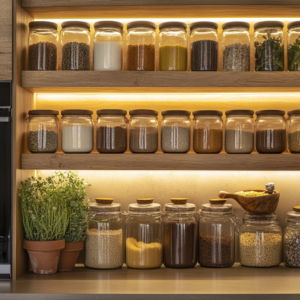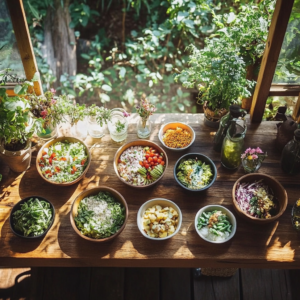Introduction
I vividly recall the day I realized I wanted to embrace a vegan lifestyle. I felt enthusiastic about the ethical and health benefits, yet also somewhat concerned: How would I adjust my eating habits? Would I be able to find enough protein? And how would I deal with social situations, or family members who might question my choices? Over time, I’ve learned that transitioning to a vegan lifestyle can be a gratifying and eye-opening experience when you equip yourself with the right knowledge, solid strategies, and a willingness to adapt to unexpected challenges. In this comprehensive guide, I want to share my experiences and insights with you. Whether your primary motivation is compassion for animals, improving your health, or reducing your environmental impact, this article will help you get started and stay successful in your vegan transformation. If you’ve been wondering how to maintain balanced nutrition, handle cravings, or talk about your new habits in social settings, I’ll address all of that. And if you’re interested in quick and convenient plant-based recipes, see Quick and Delicious Vegan Recipes for Busy Weeknights. Meanwhile, for budget-conscious ideas, you can explore Budget-Friendly Vegan Meals That Don’t Sacrifice Taste. Let’s embark on your journey toward a sustainable, rewarding vegan lifestyle.

Core Motivations Behind Veganism
Ethical Factors
One of the central appeals of veganism is its ethical foundation. Many people choose to remove animal products from their lives to reduce harm and suffering inflicted on nonhuman animals, whether in the context of meat, dairy, eggs, honey, or even clothing and cosmetics. By advocating for a diet free from animal exploitation, vegans aim to align their values—such as compassion and empathy—with their daily practices. For them, each meal becomes a reflection of their desire to minimize cruelty, and they often point to various investigations or documentary sources that highlight how modern farming can be detrimental to animal wellbeing. Beyond the direct act of consuming animal products, ethical vegans also reconsider other areas of life, including using leather, wool, or cosmetics tested on animals. The guiding principle is to reduce harm as far as is practicable. Because of this deep moral stance, once someone internalizes it, they are often more motivated to find creative ways to fulfill their nutritional needs without reverting to animal-based foods.
Health and Environmental Considerations
Not everyone transitions solely for animal rights. Others focus on health benefits, citing studies (for instance, from the Academy of Nutrition and Dietetics) that link well-planned vegan diets to lower risks of heart disease, hypertension, type 2 diabetes, or certain cancers. Fruits, vegetables, whole grains, nuts, and seeds supply plenty of vitamins, minerals, fiber, and antioxidants. If you want a deeper look at balancing nutrients for your health, see 10 Essential Vegan Nutrition Tips for a Healthier Life. Furthermore, the environmental impact of animal agriculture—deforestation, water pollution, and greenhouse gas emissions—has come under increasing scrutiny. Switching to a plant-based diet can significantly lower your carbon footprint. Organizations like the United Nations’ Food and Agriculture Organization (FAO) have noted that livestock production is a major contributor to global emissions (1). Thus, adopting veganism can align your personal choices with global concerns about sustainability, climate change, and resource conservation.
Key Takeaways
- Ethical reasons often involve compassion for animals and reducing exploitation.
- Health considerations encourage people to consume more fiber, antioxidants, and lean plant proteins.
- Environmental motivations revolve around lower greenhouse gas emissions, land use, and water conservation.
Pre-Transition Steps
Assessing Your Current Diet
Before radically shifting your dietary habits, it’s wise to examine how much meat, dairy, or eggs you currently eat. Make a quick list or log your meals for a week. Do you often rely on chicken or dairy cheese in dinner recipes? Do you drink cow’s milk in your morning coffee or cereal? Identifying these habits reveals what substitutions you’ll need—like almond or soy milk for breakfast, or swapping regular cheese with a nut-based cheese alternative. You may also want to take note of how many servings of fruits, vegetables, and whole grains you typically have each day. Moving toward veganism may mean incorporating more produce or exploring new grains. For example, if you’re not used to cooking lentils or quinoa, you’ll want to learn quick preparation techniques so you can easily meet your protein and carb requirements.
Setting Realistic Goals and Timelines
Some people flourish with an immediate, all-out vegan shift. Others prefer a more gradual timeline—removing red meat first, then poultry, then fish, before finally cutting out dairy and eggs. Reflect on your tendencies. Are you someone who adapts easily to abrupt changes, or do you need time to experiment with recipes and find replacements you truly enjoy? A popular approach is “weekday vegan,” meaning you eat fully plant-based Monday through Friday and allow for some flexibility on weekends, until you feel comfortable extending that to seven days a week. There’s no single pace that suits everyone. The main factor is to remain consistent once you decide on your method. If you go gradually, plan each phase in writing: “Week 1: remove red meat,” “Week 2: remove poultry,” “Month 2: remove fish,” “Month 3: remove dairy,” etc. This structured approach can help you track progress. If, on the other hand, you do better with immediate commitments, consider that method but be ready to quickly learn about cooking staples and B12 supplementation to avoid nutrient issues.
Key Takeaways
- Logging your current animal-based consumption highlights direct replacements or gradual cuts.
- A structured approach—whether abrupt or phased—helps build clarity and resolve.
- Combining personal motivation with actionable steps makes the transition smoother.
Organizing Your Vegan Kitchen
Essential Pantry Staples
Adopting veganism becomes far simpler when your kitchen is equipped with the right ingredients. Staples typically include:
- Legumes: Beans (black, pinto, kidney), chickpeas, lentils (red, green, brown)
- Whole Grains: Brown rice, quinoa, oats, whole wheat pasta
- Seeds and Nuts: Chia, flax, hemp, almonds, peanuts, walnuts
- Plant Milks: Soy, almond, oat, coconut—preferably fortified with calcium and vitamin B12
- Flavor Enhancers: Nutritional yeast, soy sauce, tamari, sriracha, tahini, peanut butter, assorted herbs, and spices
Canned or precooked beans cut down on time, while frozen vegetables keep well and can be tossed directly into stir-fries or soups. For cost-savvy approaches, read Budget-Friendly Vegan Meals That Don’t Sacrifice Taste.
Key Cooking Tools
While you can survive with minimal equipment, having a few sturdy items ensures you’re never stuck. A good non-stick pan, a decent chef’s knife, and a medium or large pot form the backbone of most dishes. Consider an Instant Pot or a pressure cooker if you want to cook dried legumes or grains at a fraction of the usual time. A blender or food processor also speeds up sauce-making or chopping. For further insight on essential gadgets, check Mastering Vegan Cooking: Top Tips for Beginners.
Key Takeaways
- Stock a pantry with core dry goods (grains, beans, nuts, seeds) to simplify daily cooking.
- Fortified plant milks help cover certain nutrients, like calcium or B12.
- Tools like a pressure cooker or quality non-stick skillet reduce fuss and expand your recipe repertoire.

Approaches to the Transition
Gradual vs. Overnight Changes
The question many new vegans face is whether to go 100% from day one or gradually reduce animal products. An immediate change suits individuals who feel ethically compelled and have the time to learn new recipes swiftly. However, it can be overwhelming if you haven’t researched B12 supplementation, iron absorption, or practical replacements for favorite dishes. Slower transitions, such as “meatless Mondays” or “weekday vegan,” let you try new recipes at a comfortable pace, track your nutrient intake, and learn from any early slip-ups.
Personalizing Your Vegan Journey
You might discover new cooking methods or flavor combos you never considered. For instance, if you grew up relying on cheese, you might experiment with cashew-based cheese sauce or store-bought vegan cheese alternatives. If breakfast was your daily egg ritual, tofu scramble or chickpea flour omelets might become staples. Remember, there’s no universal route; it’s about fitting plant-based choices into your lifestyle. For quick inspiration, see Quick and Delicious Vegan Recipes for Busy Weeknights.
Key Takeaways
- Abrupt transitions can feel empowering yet require prompt awareness of nutrients and replacements.
- Gradual methods let you adapt step by step, tackling dairy one month and meat another.
- Tailor your pace to your personal motivation, cooking skills, and comfort level.
Addressing Nutritional Needs
Protein, Iron, Calcium, Vitamin B12, and Omega-3s
One of the biggest concerns for new vegans is meeting protein goals. Fortunately, beans, lentils, tofu, tempeh, seitan, nuts, and seeds provide robust options. Iron is easily found in spinach, chickpeas, and lentils, yet pairing them with vitamin C sources (bell peppers, citrus fruits) amplifies absorption. Calcium arises in leafy greens and fortified plant milks or tofu with calcium sulfate. Vitamin B12 is crucial for nerve function and red blood cell formation, so in most cases, supplementation or fortified cereals/milks is recommended. For an overview of everyday B12 essentials, check Essential Vegan Supplements for Optimal Health. Omega-3 fatty acids come from chia seeds, flaxseeds, hemp seeds, and walnuts, though ALA conversion to EPA/DHA is partial.
Fortified Foods and Supplementation
Keeping a supply of fortified yeast or cereals, or regularly drinking soy or almond milk with added vitamins, helps maintain healthy levels of B12, calcium, and vitamin D. Some individuals also choose algae-based supplements to ensure direct EPA/DHA intake. If you remain uncertain about your micronutrient status, a quick blood test can offer reassurance or pinpoint any shortfalls. For more detail on building a nutritionally complete approach, read 10 Essential Vegan Nutrition Tips for a Healthier Life.
Key Takeaways
- Focus on legumes, soy products, or seitan for protein, pair iron sources with vitamin C, and incorporate B12-fortified foods or supplements.
- Calcium emerges in greens, plant milks, or calcium-set tofu.
- Seeds and walnuts provide ALA-based omega-3s, and some opt for algae supplements for direct DHA/EPA.
Building Practical Vegan Meal Plans
Balancing Macros for Energy
Aim to have protein, complex carbs, and healthy fats at each major meal. A typical day might begin with a tofu scramble (protein) plus whole wheat toast and avocado (carbs and fats). Lunch could be a chickpea and roasted veggie wrap, and dinner might feature lentil curry with brown rice. Sides of steamed or stir-fried veggies supply additional micronutrients. Eating a variety of foods also helps prevent boredom. If you need quick ideas, see Quick and Delicious Vegan Recipes for Busy Weeknights.
Sample Week Overview
- Monday: Oatmeal with berries and ground flax (breakfast), lentil soup (lunch), tofu stir-fry over brown rice (dinner).
- Tuesday: Smoothie with spinach, banana, soy milk, peanut butter (breakfast), tempeh sandwich with lettuce, tomato, and vegan mayo (lunch), seitan fajitas (dinner).
- Wednesday: Whole wheat toast with avocado and chickpea mash (breakfast), quinoa salad with roasted veggies (lunch), chickpea curry with basmati rice (dinner).
- Thursday: Vegan yogurt parfait with granola and berries (breakfast), kale and white bean soup (lunch), veggie burger patty on a whole grain bun with sweet potato fries (dinner).
- Friday: Tofu scramble with diced peppers (breakfast), leftover curry or soup (lunch), homemade veggie pizza with vegan cheese (dinner).
Feel free to tweak portion sizes, seasonings, or specific ingredients based on personal taste or cultural preferences. The aim is to ensure an enjoyable variety while meeting nutrient goals.
Key Takeaways
- Target each meal to include proteins (beans, tofu), carbs (grains), and fats (avocado, nuts).
- Rotate produce for diverse vitamins and minerals.
- A structured weekly plan prevents guesswork and facilitates consistency.

Social and Dining-Out Strategies
Communicating with Friends and Family
Adopting a vegan lifestyle can puzzle friends and relatives who are unfamiliar with plant-based diets. They might question your choices or worry about your protein intake. Calmly explaining your motivations—animal welfare, health improvements, environmental benefits—can help them understand. Offer to cook or bring a vegan dish to gatherings, showcasing that plant-based meals can be tasty for everyone. Some people worry about being pushy, but a friendly, open approach often fosters acceptance.
Tips for Restaurants, Travel, and Gatherings
- Check Menus in Advance: Many restaurants have vegetarian or vegan-friendly options, especially if you check their website or call ahead.
- Polite Requests: Politely requesting modifications—like “no cheese” or substituting extra vegetables—can get you a vegan-friendly plate.
- Travel Prepared: If you’re on a long trip, pack snacks (nuts, dried fruit, protein bars) or confirm where you can find vegan meals en route.
- Social Functions: Bring a substantial vegan dish, so you have something to eat and share. It demonstrates how plant-based fare can be flavorful and inviting to non-vegans as well.
Key Takeaways
- Approach conversations about veganism with empathy, focusing on personal reasons rather than confrontation.
- Scout restaurant menus before arriving, request polite substitutions, and ask about plant-based dishes.
- Provide a vegan option at gatherings to introduce others to new flavors while guaranteeing you have something satisfying.
Maintaining Motivation and Overcoming Obstacles
Cravings, Plateaus, and Accountability
Cravings for cheese or certain meats might surface if you previously ate them frequently. Consider exploring vegan cheese alternatives, or adding nutrient-dense, flavorful toppings like olives or nut-based sauces. Sometimes cravings reflect a macronutrient gap—like needing more protein or healthy fats. Logging your meals for a while can reveal patterns. If your progress stalls or you have doubts, reexamine your motivations and check how your daily diet matches recommended nutrient intakes. Engaging with a supportive community can also help. For daily energy pointers, see How to Boost Your Energy with a Vegan Diet.
Tapping into Vegan Communities
Online forums or social media groups let you share recipes, ask questions, and celebrate wins with like-minded folks. Local vegan meetups or potlucks, if available, can connect you with people who’ve navigated similar challenges. They can offer grocery tips, brand recommendations, or personal anecdotes on thriving in workplaces or families that aren’t fully vegan.
Key Takeaways
- Address cravings by ensuring enough protein or healthy fats, and seek out satisfying plant-based substitutes.
- Periodically track your meals and nutrients to spot any shortcomings.
- Engage with vegan communities—online or offline—to stay inspired and gather practical tips.
Relevant External Resources
Government Guidelines and YouTube Inspiration
Authorities like the USDA or the Academy of Nutrition and Dietetics (1) publish guidelines reaffirming that well-planned vegetarian and vegan diets suit every stage of life, providing you watch key nutrients. Their official websites often supply recommended intakes for nutrients like iron or B12. Additionally, YouTube channels like NutritionFacts.org break down plant-based studies in simple formats, illuminating how vegan diets tie to various health markers. While not every recipe video is perfect, you’ll likely discover quick cooking hacks or new favorite dishes.
Key Takeaways
- Government and nutrition organization documents confirm the viability of a vegan diet.
- Video content can spark creative ideas for meal prepping and flavor combos.
- Always cross-check factual data from credible sources when in doubt.
If you want to learn several recipes for delicious vegan dishes, I recommend this cookbook that was useful to me and I would like to share it with you.
Conclusion
Transitioning to a vegan lifestyle can be fulfilling, health-boosting, and aligned with deeper ethical or environmental principles. By honestly evaluating your current food habits, stocking up on essential vegan staples, learning about crucial nutrients, and staying adaptable with social situations, you’ll find that the shift needn’t be daunting. Whether you opt for a rapid change or a phased approach, keep motivations in sight and lean on the abundance of resources—like quick recipe collections or community forums—to stay inspired. For more in-depth cooking advice, explore Mastering Vegan Cooking: Top Tips for Beginners.
FAQ (Frequently Asked Questions)
Q1: Is It Hard to Get Enough Protein on a Vegan Diet?
Not if you incorporate diverse sources—like beans, lentils, tofu, tempeh, seitan, and nuts—routinely. Spreading protein across the day maintains steady energy. If you want extra assurance, track your macros for a few weeks using a nutrition app.
Q2: Do I Need Supplements After Going Vegan?
Vitamin B12 is almost always recommended for vegans unless you consume ample fortified foods daily. You may also need vitamin D or iron supplements if blood tests show a deficiency. Consulting a healthcare professional clarifies your specific needs.
Q3: How Can I Handle Social Events or Holidays?
Offer to bring a delicious vegan dish, politely explain your reasons for being vegan, and remember that patience is key as others adapt. Check menus in advance at restaurants. Over time, friends and family often become more accepting once they see your passion.
Q4: What If I Miss Cheese or Ice Cream?
Many vegan cheese brands exist, featuring coconut oil, cashews, or tofu as bases. Vegan ice creams—often made from almond, soy, or coconut milk—are widely available. Experiment to find products that match your taste preferences.
Q5: Does Vegan Cooking Require Special Equipment?
Not necessarily. Basic equipment like a skillet, pot, and good knife suffice initially. Pressure cookers or food processors can save time but are optional. Simple, affordable tools still let you whip up nutritious, tasty meals.